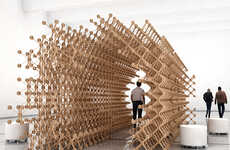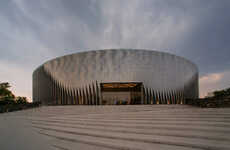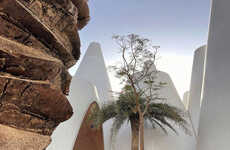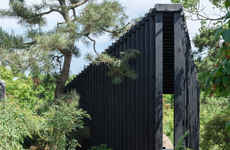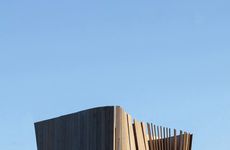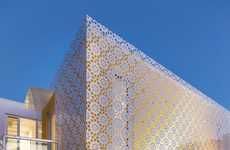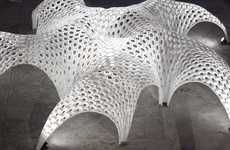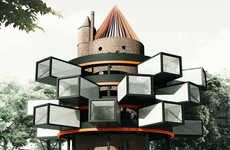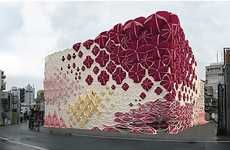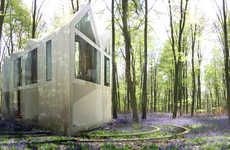
The Entangled Pavilion Self-Changes Shape At Visitors' Wishes
Jen Chae — May 23, 2013 — Art & Design
References: michaeljantzen & archinect
The Entangled Pavilion by Michael Jantzen imagines a building that can transform into its visitors’ wishes. It is a form of architecture that can be fully responsive to the people in it.
This interactive structure would consist of pivoting roof segments and support frames. Each of its four roof segments have motorized wheels that move independently.
Visitors will see a smaller model of the pavilion placed in the middle of the life-sized one. There, they will be able to move segments of the mini pavilion into whatever configuration they wish. When happy with the form of the model, visitors will be able to press the “move” button; the life-sized pavilion will then automatically position itself like the model. In essence, the structure will continually transform to accommodate the needs or taste of its visitors.
The self-changing pavilion would be an interesting and futuristic concept that could cultivate its visitors’ creativity.
This interactive structure would consist of pivoting roof segments and support frames. Each of its four roof segments have motorized wheels that move independently.
Visitors will see a smaller model of the pavilion placed in the middle of the life-sized one. There, they will be able to move segments of the mini pavilion into whatever configuration they wish. When happy with the form of the model, visitors will be able to press the “move” button; the life-sized pavilion will then automatically position itself like the model. In essence, the structure will continually transform to accommodate the needs or taste of its visitors.
The self-changing pavilion would be an interesting and futuristic concept that could cultivate its visitors’ creativity.
Trend Themes
1. Command-responsive Architecture - The concept of architecture that can transform in response to its visitors' wishes presents an opportunity for innovation in the field of responsive design.
2. Interactive Structures - The creation of interactive structures that respond to user input provides a space for innovation in interactive design.
3. Pivoting Roof Segments - The use of motorized, pivoting roof segments in architecture suggests an opportunity for innovation in the integration of mechanical engineering and architecture.
Industry Implications
1. Architecture - The concept of command-responsive pavilions presents opportunities for innovation in the field of responsive design and could be the next step in the evolution of smart buildings.
2. Interior Design - The creation of interactive structures that transform to adapt to their users' needs and preferences presents an exciting opportunity for innovation in interactive interior design.
3. Mechanical Engineering - The use of motorized, pivoting roof segments in architecture suggests an opportunity for innovation in the integration of mechanical engineering and architecture, and the development of smart materials for construction.
5.1
Score
Popularity
Activity
Freshness


